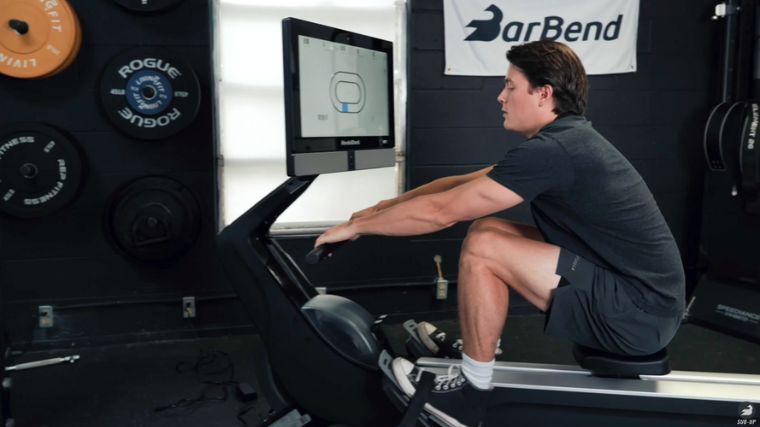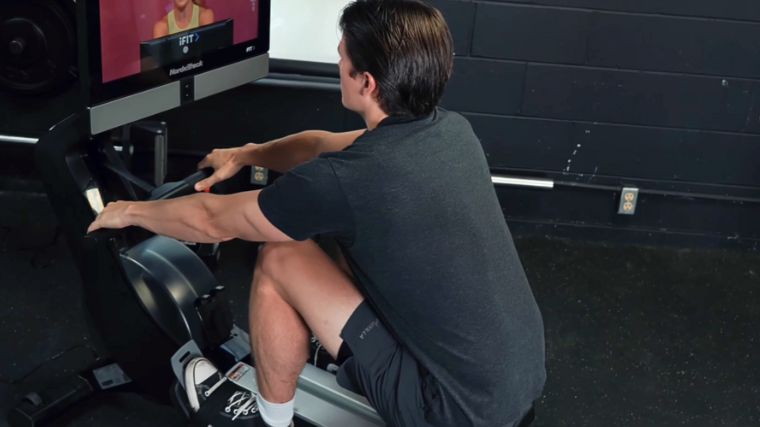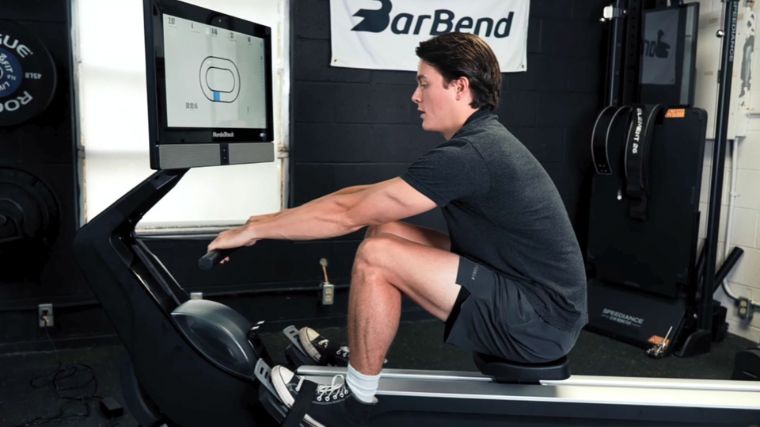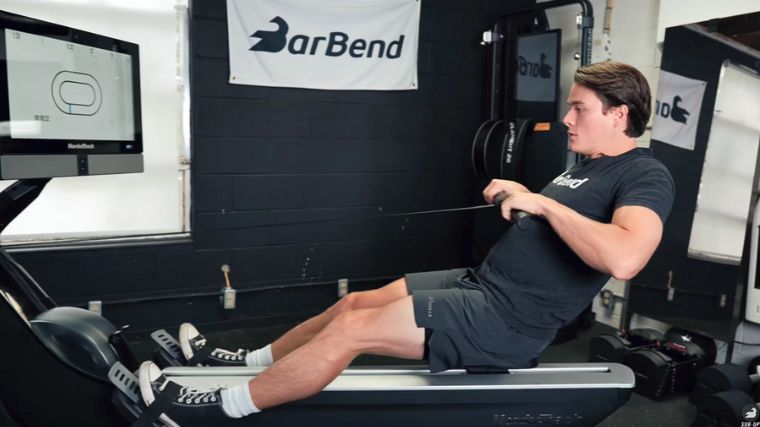Whether you’re new to the gym or prefer the lifting platform and are just newer to cardio, a rowing machine workout is a fantastic place to start. You can get a full-body session on the rower in as little as five minutes and build up from there. We’ve got the best selection of rowing workouts for beginners with room to progress. Hop on and strap in your feet.
Rowing Workouts for Beginners
- 5-Minute Rowing Workout for Beginners
- 15-Minute Rowing Workout for Beginners
- Rowing Interval Workout for Beginners
- Rowing Steady-State Workout for Beginners
- Rowing + Bodyweight Workout for Beginners
5-Minute Rowing Workout for Beginners
Step one to your first workout is nailing your rowing technique. Then, we’ll use a few different terms to help you adjust your pace. The rowing machine, or a rower or erg, measures your power output. Depending on your machine, you can track your distance, time, speed, calories, and other variables. You can also adjust your resistance.
The Workout
In this first workout, we’ll focus on the distance. After a one-minute warm-up row, you’ll aim to row 500 meters in three minutes. After those three minutes, finish with another minute to cool-down, and you’re done.

[Read More: The Best Budget Rowing Machines: All Options Under $1,500]
The time it takes you to row 500 meters is also called your split time. In this workout, you aim for a three-minute split time to get used to the form. Intermediate and advanced athletes may aim for as little as a one-minute split time.
Be sure to start this and all workouts with a complete dynamic warm-up to prepare your body.
| Warm-Up | One minute row at a moderate pace |
| Workout | 500-meter row in three minutes |
| Cool-Down | One minute row at an easy pace |
Equipment Needed: You’ll need a rowing machine. There are several different types, and any of them will work.
How Often to Do This Workout: Try this workout three times a week to get comfortable with it.
Modifications
- Make it Easier: Keep rowing to complete the 500 meters, even if you go over three minutes.
- Make it Harder: See if you can get over 500 meters in three minutes.
15-Minute Rowing Workout for Beginners
In this longer beginner workout, we’ll introduce a new term — strokes per minute, or SPM. This term, also called your stroke rate, refers to the number of strokes you take in one minute. The higher the number of strokes you take in one minute, the faster you’ll be and the lower your split time can be.
The Workout
This 15-minute rowing workout is set up as a modified pyramid. After starting with a warm-up row, you’ll increase your SPM and maintain for five minutes. Then you’ll increase again for another five minutes and work your way back down.
[Read More: The Best Water Rowing Machines on the Market]
| Warm-Up | Three minutes at a moderate pace |
| Ascending | Five minutes of rowing at 20 to 22 SPM |
| Top | Five minutes of rowing at 24 to 26 SPM |
| Descending | Five minutes of rowing at 20 to 22 SPM |
| Cool Down | Three minutes of rowing at a moderate to slow pace |
Equipment Needed: You’ll need a rowing machine that tells you your SPM on the screen.
How Often to Do This Workout: Try this one twice a week.
Modifications
- Make it Easier: Go for the lower range of suggested SPM for each level.
- Make it Harder: Aim for the higher SPM of each step.
Rowing Interval Workout for Beginners
Our next beginner workout on the rower is an interval workout. It’s a great way to prepare for high-intensity interval training (HIIT). HIIT workouts alternate short bouts of all-out effort (like sprints) with short rest or recovery phases.
The Workout
In proper HIIT, you spike your heart rate to 80 to 95 percent of your max heart rate and let it recover at 40 to 50 percent. This isn’t technically a HIIT rowing workout because you’re not going all out during your sprints. It’s more of an interval workout, so you can get used to alternating intensity while maintaining good technique as a beginner.
[Read More: Does Rowing Build Muscle? How to Get Ripped on a Rowing Machine]
After a warm-up row for three to five minutes, you’ll do 10 rounds of intervals — 30 seconds at 26 SPM and 30 seconds at 20 SPM. This is a great ratio for beginners. Finish with your cool down to let your heart rate and muscles start to recover.
| Warm-Up | Three to five minutes at a moderate pace |
| 10 Rounds of Intervals | 30 seconds at 26 SPM, 30 seconds at 20 SPM |
| Cool Down | Three to five minutes at a moderate to slow pace |
Equipment Needed: You’ll need a rower that tracks your SPM.
How Often to Do This Workout: Try this workout twice a week with plenty of rest time in between.
Modifications
- Make it Easier: You can reduce the SPM on both the sprints and recovery phases.
- Make it Harder: Kick up the SPM or try 12 to 15 rounds of intervals.
Rowing Steady-State Workout for Beginners
This rowing session is a beginner workout with steady-state cardio. Steady-state cardio is a type of cardio exercise where you sustain a moderate heart rate without resting for the duration of your workout, usually lasting 30 to 60 minutes.

[Read More: The Best Compact Exercise Equipment for Any Small Space]
It’s not like spiking your heart rate in a HIIT workout — it builds your aerobic capacity differently. Both types are suitable for all fitness levels; sometimes, it just comes down to how much time you have and your personal preferences.
The Workout
This workout takes 30 minutes total, with a five-minute warm-up and cool-down and 20 minutes at a moderate SPM. Your steady-state workout can be low to moderate in intensity. As a beginner still getting comfortable with the rowing technique, it may be helpful to try a LISS workout (low-intensity steady-state).
You’ll want your heart rate to be around 50 to 65 percent of your max heart rate. Aim for 64 to 76 percent of your max heart rate to kick it up to moderate intensity. (1)
| Warm-Up | Five minutes at a moderate pace |
| 20-Minute Row | Find the SPM you can sustain for 20 minutes without resting |
| Cool Down | Five minutes at a moderate to slow pace |
Equipment Needed: You’ll need a rowing machine and potentially a wearable fitness tracker with a heart rate monitor.
How Often to Do This Workout: Try this once or twice weekly.
Modifications
- Make it Easier: Start with 15 minutes instead of 20.
- Make it Harder: Kick up the steady-state portion to 25 or 30 minutes.
Rowing + Bodyweight Workout for Beginners
This beginner workout will take us out of the pure cardio realm and mix in strength training. The rowing machine is an excellent addition to a circuit-style workout for a burst of effort after your slow and controlled strength exercises. It also helps build up your work capacity, which translates into higher training volume and strength over time.
The Workout
This full-body workout challenges multiple muscle groups and combines strength training with cardio. Full-body workouts are often a great choice for beginners because they tax all areas of your body equally with a light load. Adding reverse lunges here also gets your glutes working since squats and the rower can be quad-dominant.
[Read More: 7 Ways to Improve Your Rowing Stroke]
If you are an advanced lifter but are coming here to get started with cardio, this still works well. Think of it more as a CrossFit workout for beginners.
Perform one exercise after another as a circuit, three to four rounds, with a 60- to 90-second rest in between.
| Bodyweight Squats | 10 |
| Reverse Lunges | 8 per side |
| Push-Ups | 8 to 10 |
| Rowing Machine | 250-meter row |
Equipment Needed: You’ll need a rowing machine and potentially a dumbbell or kettlebell to increase the difficulty of your squats and lunges.
How Often to Do This Workout: Try this workout two to three times per week.
Modifications
- Make it Easier: Do fewer lunges and take your time with rowing. For push-ups, elevate your hands, or do them with your knees down.
- Make it Harder: Add a kettlebell or dumbbell for goblet squats instead of bodyweight squats. You can also load your reverse lunges. Try to beat your time on your 250-meter row. Shorten the rest period.
Benefits of Rowing Workouts for Beginners
Here are the top benefits of rowing machine workouts for beginners to add to their routines.
Full-Body Workout
Rowing workouts are efficient. They’ll work your entire body with each rep. Just after you push with your lower body, you pull with your upper body while keeping your core engaged to protect your spine. You need to actively engage your muscles for a good-quality row, so even in a cardio workout, you get some strength training as a beginner.
Low-Impact Workout
The rowing machine is a low-impact form of cardio compared to running on a treadmill. You’re not weight-bearing, and you stay seated the whole time, but you still get your heart rate up and work all your muscle groups.

[Read More: Indoor Rowing Workouts That Won’t Bore You To Death]
That makes it a great option for beginners or people recovering from certain injuries. The rower is also great for lifters on an active recovery day to get some cardio in without adding more stress on their joints and tissues.
Works for Steady State or HIIT
The rowing machine is customizable. You can maintain one pace for a long time for a steady-state cardio workout or alternate sprints with recovery phases for HIIT. Both types of cardio are beneficial for heart health and performance. For beginners wanting to try HIIT, since it’s low-impact, it may be a more accessible bet than a HIIT treadmill workout.
Tracks Power Output to Help Progression
The rowing machine is sometimes called an erg, short for ergometer. It measures the work you put in so you can track your power output. This is helpful for rowers using an indoor rowing machine to train when they can’t row on the water. It also works well for gymgoers to track their progress.
[Read More: Air Bike Vs. Rower — the Ultimate Cardio Showdown]
The erg will show you your SPM, distance, time, and calories. You can play around with what you want to work on and increase your speed and power as you progress.
Great for Home Workouts
If you want to purchase a cardio machine, an indoor rowing machine can be a great choice. You can get a smaller rower for your home gym or one that can roll up and rest against the wall if you have a small space. This will let you bang out a quick full-body home workout that challenges all your muscles and increases your heart rate without trying to do hundreds of burpees. Of course, you can also do both.
How to Use a Rowing Machine

Here’s a step-by-step guide on how to use a rowing machine so you’ll be ready for your first workout.
- Choose Your Resistance: Use the damper next to the flywheel to choose your resistance. Beginners can start with zero or one.
- Set Up Your Feet and Hands: Sit on the seat. Place your feet on the foot pads and adjust the size to fit you. Secure the straps. Grab the handle with an overhand grip and straight wrists.
- Go Forward: This part of the rowing stroke is called the catch. Lean your upper body forward while keeping your arms straight and your head retracted. Go until your shoulders pass your hips, with your knees bent and heels slightly lifted.
- Feet First: Push your feet into the foot pedals and straighten your legs. Keep your arms straight and core engaged. Lean back slightly as your legs fully straighten.
- Row Your Arms: Pull the handle toward your body as your legs straighten, landing below your ribs. Use your back muscles and retract your scapula to initiate the pull. Keep your wrists straight.
- Return: Lean forward to initiate your next rowing stroke. Let your hands pass your knees and then re-bend them. Get as close to the flywheel as you can, and repeat.
FAQs
More questions? We’ve got answers.
What is a good rowing pace for a beginner?
As a beginner, aim for 16 to 20 SPM. Nail your technique before trying to work on your split time.
How long should a beginner work out on a rowing machine?
Beginners can start with a five-minute workout to feel it out. If you want to do an interval workout, start with 10 minutes. For a steady state, do 20 minutes.
Is rowing a good workout for beginners?
Yes, rowing is an excellent workout for beginners. It teaches you to coordinate your upper body, lower body, and core as you get into the rowing rhythm. You engage all your muscles to build strength and work capacity.
References
- CDC. Target Heart Rate and Estimated Maximum Heart Rate. Centers for Disease Control and Prevention.
Editor’s Note: The content on BarBend is meant to be informative in nature, but it should not be taken as medical advice. When starting a new training regimen and/or diet, it is always a good idea to consult with a trusted medical professional. We are not a medical resource. The opinions and articles on this site are not intended for use as diagnosis, prevention, and/or treatment of health problems. They are not substitutes for consulting a qualified medical professional.